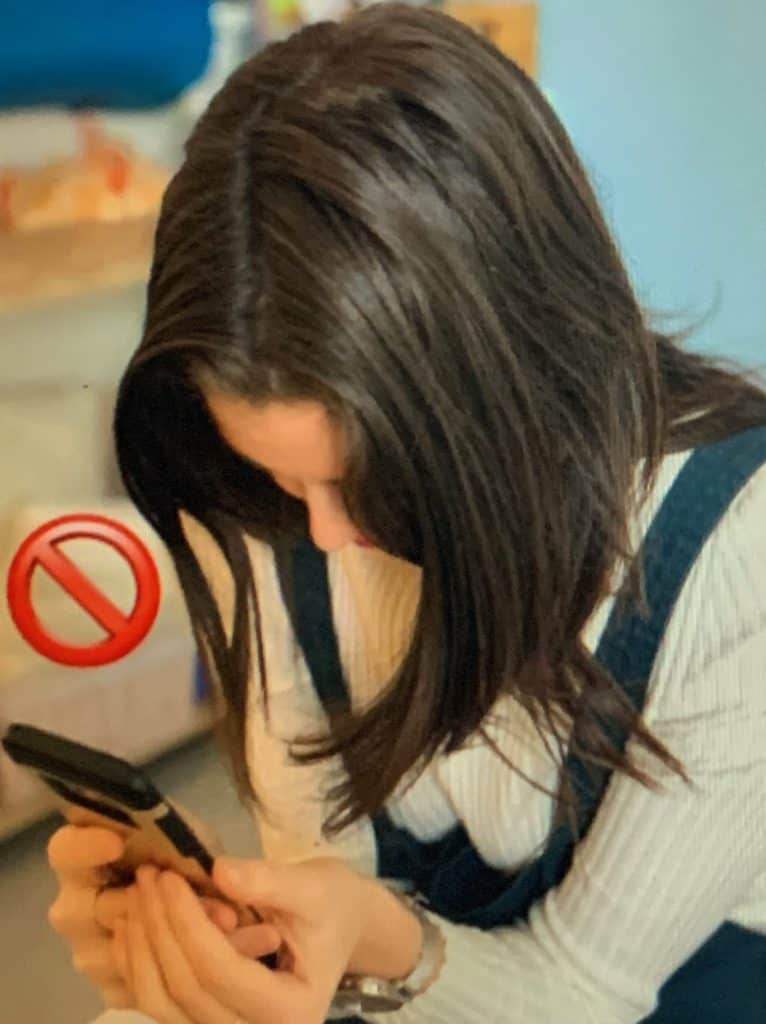Text Neck

If you have any experience with public transit in New York City, you have undoubtedly witnessed seas of strangers glued to screens, or hoards of cell phone zombies. Recent figures estimate smartphone ownership of adults 18-34 years at 92-95% in the USA and Australia. There is growing concern over mobile device usage amongst children and adolescents, as they have a greater propensity towards technology consumption. Hours spent hunched over handheld devices can lead to long-term damage to the spine and chronic pain.
Text neck is a modern term given to the loss of the natural curve in our cervical spine from spending too much time bent over a screen. It results in neck pain with a forward head posture from repetitive stress or overuse of handheld devices. The human head weighs about as much as a bowling ball or a dozen pounds, and for every inch of forward head translation, the relative weight of the head on the neck is doubled.
Tilting the head forward to 15 degrees places about 27 pounds of force on the neck, 40 pounds at 30 degrees, 49 pounds at 45 degrees, and 60 pounds at 60 degrees.
Pain, stiffness, and soreness are among the most common symptoms reported with Text Neck. Other symptoms can include headaches, radiating pain, or muscle weakness. However, there are more serious consequences associated with increased loading forces on the cervical spine, which include:
- Loss of natural spinal curvature
- Arthritis
- Spinal disc compression & degeneration
- Impaired breathing mechanics
Posture Awareness & Exercise Can Help!
Postural awareness can help reduce the repetitive stress and strain to the neck that occurs with Text Neck. Learning about ergonomics can reinforce healthy behaviors that protect your spine and helps to improve body awareness. A recent systematic review recommends guidelines to avoid injury with handheld devices:
- Avoid excessive usage and take frequent breaks.
- Avoid prolonged static postures.
- Position the device such that it reduces stresses both on the head/neck and the upper extremities.
- Avoid high repetitions of movements such as prolonged typing or swiping.
- Avoid holding large or heavy devices in one hand for a long duration.
Exercise really is the best medicine, as it is an effective tool to combat the repetitive daily postures that alter the natural curve of the neck. Chin tucking exercises and range of motion stretches can be used to help lengthen shortened muscles, alleviate pain, and improve posture awareness. A 2017 study in the Journal of Physical Therapy Science found simple neck exercises, improved Text Neck or forward head posture due to smartphone use in only 4 weeks.
Smart Phone Posture


Tip: Avoid rounding the spine over the device
Avoid dropping the head forward


Tip: Keep the chin tucked with the back of the neck long. Drop only your eyes. Bring the device to eye level as you keep the neck long.
When To See A PT
Physical therapy is a non-invasive and effective approach to treating chronic pain and stress or strain injuries like Text Neck. A rehabilitation program will likely include various types of manual therapy such as soft tissue massage, myofascial release, or trigger point release. Treatment can also include passive or active stretching, muscle strengthening, home exercise program, and re-education of the muscles postural muscles.
Body Harmony Physical Therapy offers one-on-one treatment sessions and provides individualized treatment programs for each patient.
Written by: Victoria Garrett, PT, DPT
References:
- Text Neck. (2019, August 23). Physiopedia,. Retrieved 14:48, February 17, 2020 from https://www.physio-pedia.com/index.php?title=Text_Neck&oldid=220199.
- Toh, S. H., Coenen, P., Howie, E. K., & Straker, L. M. (2017). The associations of mobile touch screen device use with musculoskeletal symptoms and exposures: A systematic review [Abstract]. Plos One, 12(8). doi:10.1371/journal.pone.0181220
- Kong, Y. S., Kim, Y. M., & Shim, J. M. (2017). The effect of modified cervical exercise on smartphone users with forward head posture. Journal of physical therapy science, 29(2), 328–331. https://doi.org/10.1589/jpts.29.328







